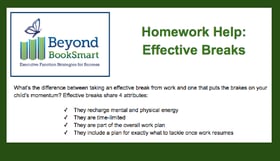Imagine a community where hundreds of familiar faces gather  together to socialize, where the possibilities for exploration are endless, and all of it is accessible with the push of a finger. In your child’s world, this place exists: it’s called YouTube. Since its creation, YouTube has transformed from a massive, hodge-podge collection of videos to a sanctuary for younger viewers seeking engaging content from people they have come to know and love. Spend 15 minutes browsing some of the site’s most popular videos and it’s not difficult to see why a student may choose YouTube over homework. As an adult who occasionally falls into the time-sucking black hole vortex of YouTube, let me share with you the 5 main reasons why this particular website can be so habit-forming, especially for younger audiences. I'll follow-up with 5 tips for parents who want to put some limits on their children's YouTube watching.
together to socialize, where the possibilities for exploration are endless, and all of it is accessible with the push of a finger. In your child’s world, this place exists: it’s called YouTube. Since its creation, YouTube has transformed from a massive, hodge-podge collection of videos to a sanctuary for younger viewers seeking engaging content from people they have come to know and love. Spend 15 minutes browsing some of the site’s most popular videos and it’s not difficult to see why a student may choose YouTube over homework. As an adult who occasionally falls into the time-sucking black hole vortex of YouTube, let me share with you the 5 main reasons why this particular website can be so habit-forming, especially for younger audiences. I'll follow-up with 5 tips for parents who want to put some limits on their children's YouTube watching.
1) Endless variety and customization
Whether your child is interested in video games, art, fishing, makeup, sports, or any combination of the above, they are sure to find their own niche on YouTube. Picture a TV channel which only shows the content you choose from a variety of likable personalities who share your interests. YouTube provides a whole world of virtual possibilities at your child’s fingertips, completely personalized and available 24/7, on demand.
2) Easy access
Another feature of YouTube is how easily accessible it is to anyone with an internet connection. Engaging content is always just a few clicks away. Getting started on YouTube takes barely any time or thought at all compared to starting a homework assignment, even more so if the homework is “boring." Students who struggle with task initiation often have difficulty summoning the cognitive energy to do homework. It takes only a few moments for a student to log into YouTube and derail their plans for beginning work, despite the best intentions. In fact, many popular YouTubers will jokingly say to the viewer, “Go finish your homework!” knowing the alluring simplicity of YouTube videos draws students away from tasks which require more energy to begin.
3) Instant gratification
Not only is logging into YouTube faster and easier than starting homework, but it’s also extremely gratifying. YouTubers who are popular with younger audiences often create bright, colorful thumbnails and intriguing, click-baity titles to entice kids into watching their videos. While we as adults may be able to overlook these tactics, children and young adults are still developing their Executive Function skills such as inhibition, or their ability to step on the brakes when faced with appealing options. Students who struggle in this area may not be able to resist clicking on and watching a video that’s catered specifically to them.
4) Designed for binge-watching
Along the same lines, a student’s ability to shift mindset and change direction is challenged by YouTube’s inherent design. When one video finishes, another recommended video begins automatically in about 10 seconds. The sidebar is also filled with other personalized video recommendations based on what your child has already watched. YouTube’s aim is to encourage serial video-watching, which is why some students find it incredibly difficult to break away once they start.
5) Familiarity with YouTube creators
Ask your child who their favorite YouTubers are and watch their eyes light up as they list off several names. Part of what makes YouTube’s content so engaging are the vibrant personalities behind it. Children and young adults get to know their favorite YouTubers over weeks, months, and even years of watching their videos. Some YouTubers refer to their fans as “family” and create communities where viewers can talk to one another and bond over their shared interest in a particular creator. Some students who struggle socially at school seek comfort in these online communities where they share a common bond with others.
Now that you have more understanding of what makes YouTube so addictive, you may be wondering what you can do to help your child sign off and re-focus on their academic priorities. Here are 5 ideas to get you started:
1) Empathize with your child
Let them know spending too much time on a particular website is a completely normal experience, and sometimes adults struggle, too. This would be a good opportunity to share some of your internet time-wasters: Pinterest? Facebook? Online shopping? In this age of endless distractions, we all have our vulnerabilities.
2) Team up for accountability
Make a plan with your child to hold each other accountable for online excesses. Since you are both making changes together, you’re on the same team. (So much more effective than being the internet police force in your family!) You could even practice a more mindful approach to online behavior by using the Self-Control app, which blocks access to any sites you and your child choose for a specified period of time.
3) Establish boundaries
Create a YouTube-free zone for schoolwork. Designate one computer in the house as the working computer, where distracting websites are off limits. You and your child could get creative, making reminder signs to hang in the area or attach directly to the computer. If multiple computers aren’t available, try using two different internet browsers (i.e., Chrome, Safari, Firefox, etc); one for work and the other for fun.
4) Use the buddy system
For more change-reluctant or impulsive students, doing homework in a public part of the house may offer them the accountability they need to stay focused. Sometimes having a work buddy sitting nearby, such as yourself or an older sibling, can be a useful strategy to resist the lure of YouTube. Check in occasionally with your child to help them learn the benefit of monitoring their own behavior (more time on track = more free time!). When they begin to drift, you can guide them back to the task at hand, reminding them that YouTube will still be there when homework is finished.
5) Explore the reasons
As Executive Function coaches, we help our students gain insight about their learning and their work behavior because this builds metacognitive skills and leads to more effective habits. Ask your child when they might feel an urge to watch a video when they are doing homework - Is it when they feel bored? Frustrated? Stuck? Lonely? Brainstorm ways to address their reasons for escaping to the world of YouTube when they have other priorities - and help your child anticipate those triggers before settling down to do work.
Photo credit: Shutterstock
Please see this page for comprehensive information about Executive Function in Elementary students.
Does your child take endless breaks while doing homework — drawing out work time for hours? Download our handy guide for creating a customized list of effective, time-limited breaks that help refresh and refocus your child.


